Waterproofing Membranes Market
Waterproofing Membranes Market Size and Share Forecast Outlook 2025 to 2035
Waterproofing membranes market is projected to grow from USD 35.0 billion in 2025 to USD 49.4 billion by 2035, at a CAGR of 3.5%. Bituminous will dominate with a 41.0% market share, while roofing will lead the application segment with a 47.0% share.
Waterproofing Membranes Market Forecast and Outlook 2025 to 2035
The global waterproofing membranes market is valued at USD 35.0 billion in 2025. It is slated to reach USD 49.5 billion by 2035, recording an absolute increase of USD 14.5 billion over the forecast period. This translates into a total growth of 41.4%, with the market forecast to expand at a CAGR of 3.5% between 2025 and 2035.
The overall market size is expected to grow by nearly 1.41X during the same period, supported by increasing infrastructure development, growing urbanization demands, and rising adoption of advanced waterproofing solutions across diverse construction, residential, commercial, and industrial applications.
Quick Stats for Waterproofing Membranes Market
- Waterproofing Membranes Market Value (2025): USD 35.0 billion
- Waterproofing Membranes Market Forecast Value (2035): USD 49.5 billion
- Waterproofing Membranes Market Forecast CAGR: 3.5%
- Leading Material in Waterproofing Membranes Market: Bituminous
- Key Growth Regions in Waterproofing Membranes Market: Asia Pacific, North America, and Europe
- Key Players in Waterproofing Membranes Market: Sika, GAF, Carlisle Companies, Soprema, Mapei, BASF
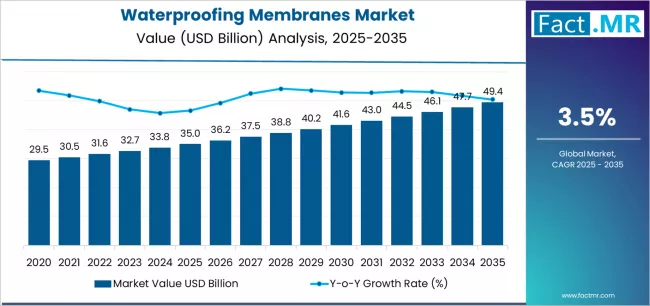
Between 2025 and 2030, the waterproofing membranes market is projected to expand from USD 35.0 billion to USD 41.6 billion, resulting in a value increase of USD 6.6 billion, which represents 45.5% of the total forecast growth for the decade. This phase of development will be shaped by increasing construction activities, rising climate resilience requirements, and growing adoption of sustainable building materials. Construction companies and building material manufacturers are expanding their waterproofing membrane capabilities to address the growing demand for durable and reliable building envelope solutions that ensure structural protection and energy efficiency.
Waterproofing Membranes Market Key Takeaways
| Metric | Value |
|---|---|
| Estimated Value in (2025E) | USD 35.0 billion |
| Forecast Value in (2035F) | USD 49.5 billion |
| Forecast CAGR (2025 to 2035) | 3.5% |
From 2030 to 2035, the market is forecast to grow from USD 41.6 billion to USD 49.5 billion, adding another USD 7.9 billion, which constitutes 54.5% of the overall ten-year expansion. This period is expected to be characterized by the expansion of green building initiatives, the development of smart membrane technologies, and the growth of specialized applications for infrastructure resilience and climate adaptation. The growing adoption of sustainable construction practices and advanced membrane systems will drive demand for waterproofing solutions with enhanced durability and environmental performance characteristics.
Between 2020 and 2025, the waterproofing membranes market experienced steady growth, driven by increasing construction industry expansion and growing recognition of waterproofing systems as essential components for ensuring building durability and performance across diverse residential, commercial, and infrastructure applications. The market developed as construction professionals recognized the potential for advanced membrane technology to prevent water damage, support energy efficiency, and enable long-term structural protection while meeting stringent building codes and environmental requirements. Technological advancement in membrane materials and installation methods began emphasizing the critical importance of maintaining system integrity and performance reliability in challenging environmental conditions.
Why is the Waterproofing Membranes Market Growing?
Market expansion is being supported by the increasing global construction activities driven by urbanization and infrastructure development needs, alongside the corresponding demand for reliable building protection systems that can prevent water damage, ensure structural integrity, and maintain building performance across various roofing, below-grade, foundation, and infrastructure applications. Modern construction companies and building owners are increasingly focused on implementing waterproofing membrane solutions that can provide long-term protection, support energy efficiency, and ensure cost-effectiveness while meeting comprehensive building codes and environmental standards.
The growing emphasis on climate resilience and sustainable construction is driving demand for waterproofing membranes that can support extreme weather protection, enable green building certification, and ensure comprehensive environmental performance. Construction professionals' preference for building systems that combine protective effectiveness with sustainability credentials and energy efficiency benefits is creating opportunities for innovative waterproofing implementations. The rising influence of building performance standards and insurance requirements is also contributing to increased adoption of waterproofing membrane systems that can provide risk mitigation benefits without compromising construction efficiency or cost-effectiveness.
Segmental Analysis
The market is segmented by material, application, and end use. By material, the market is divided into bituminous, PVC/TPO, and EPDM & others categories. Based on application, the market is categorized into roofing, below-grade & foundations, and tunnels & waterworks. By end use, the market includes non-residential and residential sectors. Regionally, the market is divided into North America, Europe, Asia Pacific, Latin America, and Middle East & Africa.
By Material, the Bituminous Segment Leads the Market
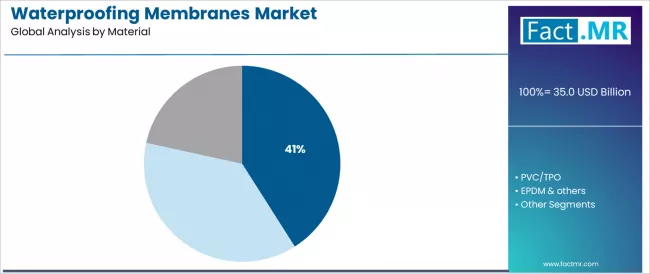
The bituminous segment is projected to maintain its leading position in the waterproofing membranes market in 2025 with a 41.0% market share, reaffirming its role as the preferred material category for traditional waterproofing applications and established construction practices. Construction companies increasingly utilize bituminous membranes for their proven performance reliability, established cost-effectiveness, and demonstrated effectiveness in providing long-term waterproofing protection while supporting diverse application requirements and installation methods. Bituminous technology's established performance and widespread acceptance directly address the industry requirements for reliable waterproofing solutions and comprehensive building protection across diverse construction projects and environmental conditions.
This material segment forms the foundation of traditional waterproofing applications, as it represents the membrane type with the greatest contribution to established performance and commercial acceptance across multiple construction applications and global markets. Construction industry investments in proven waterproofing technologies continue to strengthen adoption among contractors and specifiers. With growing demands for cost-effective protection and established performance reliability, bituminous membranes align with both performance requirements and economic efficiency objectives, making them the central component of comprehensive waterproofing strategies.
By Application, the Roofing Segment Dominates Market Demand
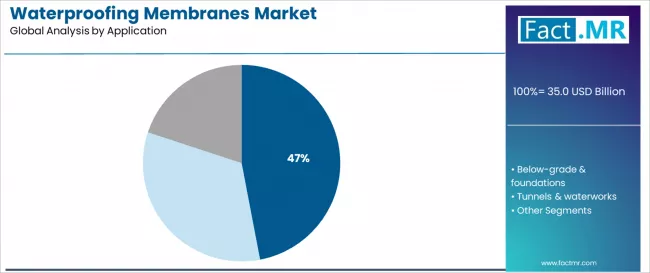
The roofing application segment is projected to represent the largest share of waterproofing membrane demand in 2025 with a 47.0% market share, underscoring its critical role as the primary driver for membrane adoption across commercial, residential, and industrial roofing systems. Construction contractors prefer waterproofing membranes for roofing applications due to their proven weather protection capabilities, established installation methods, and ability to ensure long-term building envelope performance while supporting energy efficiency and regulatory compliance. Positioned as essential components for modern roofing systems, waterproofing membranes offer both protective advantages and energy performance benefits.
The segment is supported by continuous innovation in roofing technologies and the growing availability of specialized membrane systems that enable superior performance with enhanced durability and installation efficiency. Roofing contractors are investing in comprehensive waterproofing programs to support increasingly stringent building performance requirements and climate resilience expectations. As building standards advance and weather protection becomes critical, the roofing application will continue to dominate the market while supporting advanced membrane utilization and roofing system optimization strategies.
What are the Drivers, Restraints, and Key Trends of the Waterproofing Membranes Market?
The waterproofing membranes market is advancing steadily due to increasing demand for building protection driven by construction industry growth and growing adoption of climate-resilient construction practices that require effective membrane systems providing water damage prevention, structural protection, and long-term performance across diverse roofing, foundation, infrastructure, and specialty construction applications. The market faces challenges, including fluctuating raw material costs and petroleum dependency, competition from alternative waterproofing methods and construction approaches, and installation complexity related to specialized application requirements and quality control. Innovation in sustainable materials and advanced installation technologies continues to influence product development and market expansion patterns.
Expansion of Green Building and Sustainable Construction Applications
The growing adoption of green building practices is driving demand for waterproofing membranes that address sustainability requirements, support LEED certification objectives, and provide environmental benefits while maintaining protective performance and cost-effectiveness. Sustainable construction projects require membrane systems with enhanced environmental profiles, proven recyclability, and reduced carbon footprint that enable green building compliance without compromising protective effectiveness. Construction companies are increasingly recognizing the competitive advantages of sustainable membrane integration for green building certification and environmental positioning, creating opportunities for bio-based formulations and recycled content systems designed for environmentally conscious construction and sustainable building development.
Integration of Smart Building Technologies and Performance Monitoring
Modern membrane manufacturers are incorporating smart building technologies and monitoring systems to enhance building performance management, optimize maintenance scheduling, and support comprehensive asset management through integrated sensor systems and data analytics platforms. Leading companies are developing membrane systems with integrated monitoring capabilities, implementing performance tracking technologies, and advancing building intelligence systems that provide real-time performance data while maintaining protective integrity. These technologies improve building management while enabling new market opportunities, including predictive maintenance systems, performance optimization services, and intelligent building envelope management. Advanced technology integration also allows building owners to support comprehensive facility management objectives and operational optimization beyond traditional protection approaches.
Development of Climate Adaptation and Extreme Weather Applications
The expansion of climate change adaptation requirements and extreme weather resilience is driving demand for waterproofing membranes with enhanced weather resistance, improved temperature stability, and superior performance under challenging environmental conditions that exceed traditional building protection specifications. These advanced applications require specialized membrane technologies with enhanced environmental resistance specifications that support infrastructure resilience and long-term performance, creating premium market segments with differentiated value propositions. Manufacturers are investing in climate adaptation technologies and extreme weather testing capabilities to serve emerging resilient construction applications while supporting innovation in climate-resilient building design and adaptive infrastructure development.
Analysis of the Waterproofing Membranes Market by Key Countries
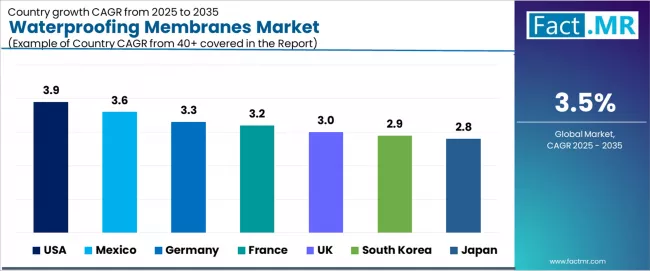
| Country | CAGR (2025-2035) |
|---|---|
| USA | 3.9% |
| Mexico | 3.6% |
| Germany | 3.3% |
| France | 3.2% |
| UK | 3.0% |
| South Korea | 2.9% |
| Japan | 2.8% |
The waterproofing membranes market is experiencing solid growth globally, with the USA leading at a 3.9% CAGR through 2035, driven by expanding construction activities, comprehensive infrastructure modernization programs, and increasing adoption of advanced building protection systems supported by building code requirements and climate resilience initiatives. Mexico follows at 3.6%, supported by rapid urban development, growing construction industry, and increasing investment in infrastructure development projects. Germany shows growth at 3.3%, emphasizing construction excellence, sustainable building practices, and advanced membrane technology development. France demonstrates 3.2% growth, supported by construction industry strength, infrastructure modernization, and comprehensive building performance standards. The UK records 3.0%, focusing on building regulation compliance, climate adaptation requirements, and construction industry modernization. South Korea exhibits 2.9% growth, emphasizing urban development, advanced construction technologies, and building performance optimization. Japan shows 2.8% growth, supported by infrastructure maintenance excellence, disaster resilience construction, and advanced building technologies.
The report covers an in-depth analysis of 40+ countries; seven top-performing countries are highlighted below.
USA Leads Global Market Growth with Infrastructure Development and Advanced Building Standards
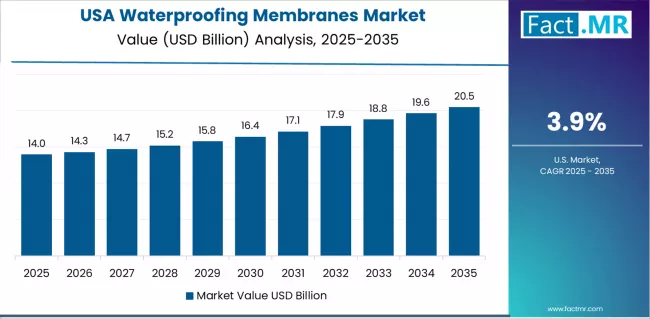
Revenue from waterproofing membranes in the USA is projected to exhibit exceptional growth with a CAGR of 3.9% through 2035, driven by expanding construction activities and comprehensive infrastructure modernization supported by federal funding and increasing focus on building resilience and performance optimization. The country's massive construction industry and advanced building code requirements are creating substantial demand for reliable waterproofing membrane solutions. Major construction companies and building material manufacturers are establishing comprehensive membrane processing and application capabilities to serve both domestic construction needs and export opportunities.
- Growing infrastructure investment and building modernization programs are driving demand for waterproofing membranes throughout major construction projects and facility upgrades across commercial, residential, and infrastructure applications nationwide.
- Strong building code requirements and performance standards are supporting membrane adoption among contractors and specifiers seeking regulatory compliance and long-term building protection in diverse climate conditions.
- Advanced construction technologies and building performance optimization are creating opportunities for specialized membrane systems throughout major construction centers and building science research institutions.
- Expanding climate resilience initiatives and extreme weather preparation are driving demand for advanced membrane solutions supporting building adaptation and risk mitigation across vulnerable regions and infrastructure systems.
Mexico Demonstrates Strong Market Potential with Urban Development and Construction Growth
Demand for waterproofing membranes in Mexico is expanding at a CAGR of 3.6%, supported by rapid urban development, growing construction industry capabilities, and increasing investment in infrastructure development supporting membrane integration across diverse construction and infrastructure applications. The country's expanding construction sector and urbanization trends are driving sophisticated membrane utilization throughout residential, commercial, and infrastructure projects. Leading construction companies and material suppliers are establishing extensive membrane distribution and application capabilities.
- Rapid urban development and expanding construction activities are creating opportunities for waterproofing membrane adoption throughout major metropolitan areas and infrastructure projects serving growing urban populations and economic development.
- Growing infrastructure investment and modernization programs are driving membrane adoption among contractors seeking reliable building protection and long-term performance in diverse climate conditions.
- Strategic geographic advantages and trade relationships are supporting membrane market development including efficient supply chains, competitive cost structures, and access to North American construction expertise and technologies.
- Expanding tourism infrastructure and commercial development projects are enabling specialized membrane applications supporting diverse construction requirements and performance standards throughout major development regions.
Germany Emphasizes Construction Excellence with Sustainable Building and Technology Innovation
Revenue from waterproofing membranes in Germany is growing at a CAGR of 3.3%, supported by the country's construction industry excellence, established sustainable building practices, and advanced membrane technology development supporting high-quality waterproofing applications. Germany's construction expertise and environmental focus are supporting investment in sophisticated membrane solutions. Major construction companies and material manufacturers are establishing comprehensive development and quality assurance programs for advanced membrane systems.
- Advanced construction industry capabilities and building performance excellence are creating demand for high-quality waterproofing membranes throughout major construction projects and building systems emphasizing durability and performance optimization.
- Strong sustainable building practices and environmental compliance requirements are driving the development of eco-friendly membrane systems including recyclable materials, reduced environmental impact, and green building compliance throughout construction operations.
- Comprehensive building codes and quality standards are advancing membrane applications including performance validation, durability requirements, and installation excellence throughout major construction and infrastructure projects.
- Export market leadership and international construction reputation are enabling German membrane solutions to access global markets while maintaining premium positioning and technology advancement advantages.
France Shows Construction Strength with Infrastructure Excellence and Building Innovation
Demand for waterproofing membranes in France is anticipated to expand at a CAGR of 3.2%, driven by construction industry excellence, established infrastructure capabilities, and comprehensive building innovation programs supporting membrane development in construction and infrastructure applications. The country's construction heritage and innovation focus are creating opportunities for sophisticated membrane utilization. Leading construction companies and infrastructure agencies are establishing comprehensive building protection programs incorporating performance optimization and durability enhancement.
- Strong construction industry and infrastructure expertise are creating demand for advanced waterproofing membranes throughout major construction projects and infrastructure systems emphasizing long-term performance and durability.
- Established building innovation capabilities and construction technology development are supporting membrane integration including performance enhancement, installation optimization, and building system integration throughout major construction operations.
- Comprehensive building standards and performance requirements are advancing membrane applications including quality assurance, installation excellence, and long-term reliability throughout major construction and renovation projects.
- Premium construction culture and building quality expectations are driving demand for superior membrane solutions supporting luxury construction applications and high-performance building development throughout major metropolitan regions.
UK Demonstrates Building Excellence with Regulatory Compliance and Climate Adaptation
Revenue from waterproofing membranes in the UK is forecasted to grow at a CAGR of 3.0%, supported by comprehensive building regulation compliance, established climate adaptation requirements, and construction industry modernization emphasizing membrane integration for performance enhancement and regulatory alignment. The country's building standards leadership and regulatory framework are driving membrane adoption throughout diverse construction sectors. Leading construction companies and regulatory bodies are establishing comprehensive building protection strategies and compliance programs.
- Comprehensive building regulations and performance standards are creating systematic market opportunities for waterproofing membranes throughout major construction projects and building systems emphasizing compliance and performance optimization.
- Growing climate adaptation requirements and weather resilience initiatives are supporting membrane development including extreme weather protection, building durability enhancement, and climate resilience integration across construction projects.
- Advanced construction technology applications and building performance optimization programs are enabling membrane integration in challenging applications including heritage buildings and complex construction environments throughout major construction centers.
- Innovation in building science and construction technology is supporting membrane utilization enhancement including performance monitoring, installation improvement, and building system optimization throughout modern construction operations.
South Korea Emphasizes Urban Development with Advanced Construction and Building Innovation
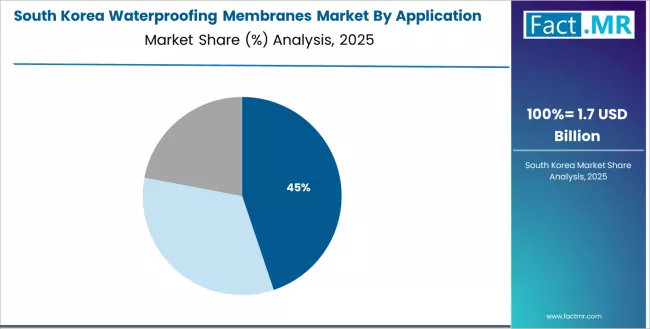
Demand for waterproofing membranes in South Korea is expanding at a CAGR of 2.9%, supported by comprehensive urban development, advanced construction technologies, and building performance optimization emphasizing membrane integration for construction enhancement and urban infrastructure development. The country's construction excellence and technology focus are driving sophisticated membrane utilization in urban and infrastructure applications. Leading construction companies and urban developers are establishing advanced membrane processing and application capabilities.
- Comprehensive urban development and construction excellence are creating demand for waterproofing membranes throughout major urban projects and building systems emphasizing performance optimization and construction quality.
- Advanced construction technologies and building innovation capabilities are supporting membrane integration in diverse applications including high-rise construction, infrastructure projects, and specialized building systems.
- Technology integration focus and construction innovation are advancing membrane applications including installation optimization, performance enhancement, and building system integration throughout major construction and urban development projects.
- Export construction capabilities and international project development are enabling South Korean membrane expertise to serve global markets while maintaining quality standards and technological advancement advantages.
Japan Shows Construction Excellence with Infrastructure Maintenance and Disaster Resilience
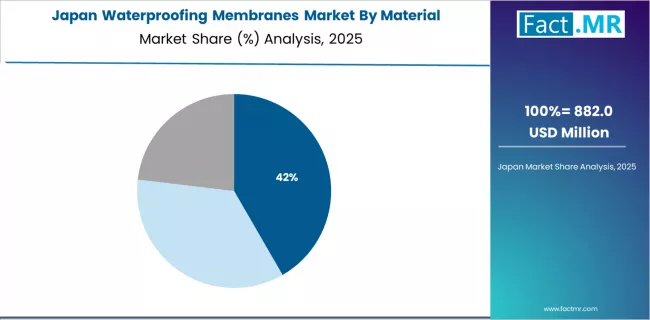
Revenue from waterproofing membranes in Japan is growing at a CAGR of 2.8%, driven by exceptional construction standards, established infrastructure maintenance capabilities, and comprehensive disaster resilience programs emphasizing superior membrane performance and reliability. The country's commitment to construction excellence and disaster preparedness are creating opportunities for ultra-high-performance membrane applications. Leading construction companies and infrastructure agencies are establishing comprehensive quality control and resilience programs.
- Exceptional construction standards and infrastructure maintenance excellence are creating demand for ultra-high-quality waterproofing membranes meeting Japanese construction industry requirements for performance consistency and long-term reliability.
- Advanced disaster resilience and seismic construction capabilities are supporting membrane applications including flexible waterproofing systems, damage resistance, and rapid recovery construction throughout major infrastructure networks.
- Comprehensive quality control systems and rigorous performance standards are ensuring superior membrane consistency and reliability throughout major construction projects and infrastructure maintenance operations.
- Construction innovation culture and continuous improvement focus are driving demand for membrane solutions that combine performance excellence with environmental responsibility and sustainable construction practices.
Europe Market Split by Countries
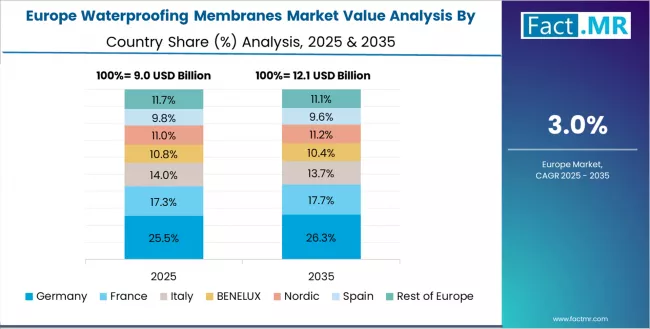
The waterproofing membranes market in Europe is projected to grow from USD 10.5 billion in 2025 to USD 14.9 billion by 2035, registering a CAGR of 3.6% over the forecast period. Germany is expected to maintain leadership with a 26.0% market share in 2025, moderating to 25.8% by 2035, supported by construction industry excellence, sustainable building practices, and advanced membrane technology development.
France follows with 19.5% in 2025, projected at 19.7% by 2035, driven by construction industry strength, infrastructure modernization, and building innovation programs. The United Kingdom holds 17.0% in 2025, expected to reach 17.2% by 2035 on the back of building regulation compliance and climate adaptation requirements. Italy commands 13.5% in 2025, rising slightly to 13.6% by 2035, while Spain accounts for 11.0% in 2025, reaching 11.2% by 2035 aided by construction growth and infrastructure development. The Netherlands maintains 5.5% in 2025, up to 5.6% by 2035 due to advanced construction technologies and sustainable building focus. The Rest of Europe region, including Nordic countries, Central & Eastern Europe, and other markets, is anticipated to hold 7.5% in 2025 and 7.1% by 2035, reflecting steady growth in construction modernization and building performance standards.
Competitive Landscape of the Waterproofing Membranes Market
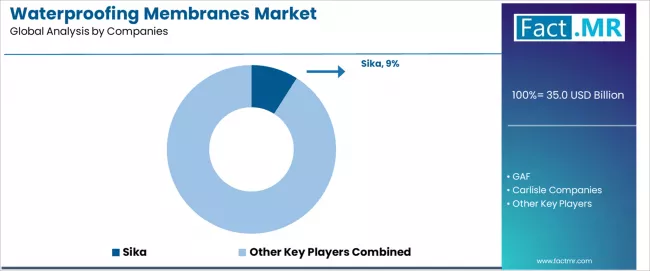
The waterproofing membranes market is characterized by competition among established building materials manufacturers, specialty membrane producers, and integrated construction solution providers. Companies are investing in material technology development, sustainability initiatives, application-specific solution development, and manufacturing capacity expansion to deliver high-performance, durable, and cost-effective waterproofing membrane solutions. Innovation in sustainable materials, installation technologies, and performance enhancement systems is central to strengthening market position and competitive advantage.
Sika leads the market with a 9.0% share, offering comprehensive waterproofing membrane solutions with a focus on construction excellence, sustainability integration, and technical innovation across diverse roofing, below-grade, and infrastructure applications. The company has announced major production capacity expansions and sustainability program development, with plans to incorporate advanced membrane technologies and sustainable production systems, with facility upgrades initiated in 2024 and enhanced capabilities planned for 2026. GAF provides innovative roofing solutions with emphasis on membrane technology advancement, having advanced their waterproofing strategy by expanding product portfolios and developing specialized systems for commercial and residential applications.
Carlisle Companies delivers comprehensive building envelope solutions including advanced waterproofing membrane systems with focus on commercial and industrial applications. Soprema offers specialized waterproofing solutions with emphasis on European markets and sustainable technologies. Mapei provides construction chemicals and waterproofing systems with focus on technical excellence and application support. BASF delivers chemical solutions including waterproofing membranes for diverse construction applications. Tremco specializes in building sealants and waterproofing systems. Johns Manville offers building materials including membrane waterproofing solutions. Fosroc provides construction chemicals and waterproofing systems for infrastructure applications. Asian Paints delivers building protection solutions including waterproofing membrane systems.
Waterproofing Membranes Market - Stakeholder Contribution Framework
Waterproofing membranes represent a critical building materials segment within construction and infrastructure applications, projected to grow from USD 35.0 billion in 2025 to USD 49.5 billion by 2035 at a 3.5% CAGR. These protective membrane systems—primarily bituminous, polymeric, and synthetic materials—serve as essential building envelope components in roofing systems, foundation protection, and infrastructure waterproofing where moisture management, structural protection, and long-term durability are critical. Market expansion is driven by increasing construction activities, growing urbanization demands, expanding infrastructure development, and rising adoption of climate-resilient construction practices across diverse residential, commercial, and infrastructure segments.
How Construction Industry Regulators Could Strengthen Building Standards and Performance Requirements
- Waterproofing Performance Standards and Building Codes: Establish comprehensive technical specifications for waterproofing membrane systems including durability requirements, installation standards, and performance validation that ensure building protection while enabling innovation and cost-effective construction solutions across diverse climate conditions and application environments.
- Quality Assurance and Installation Certification: Develop standardized installation protocols and contractor certification programs including training requirements, quality control procedures, and performance warranty standards that ensure consistent waterproofing effectiveness while maintaining professional competency and installation excellence.
- Climate Resilience and Adaptation Requirements: Create comprehensive building standards for extreme weather protection including wind resistance, temperature cycling, and flood protection that promote climate-resilient construction while supporting community safety and infrastructure protection objectives.
- Sustainability and Environmental Impact Assessment: Implement comprehensive evaluation frameworks for waterproofing materials including lifecycle assessment, recyclability requirements, and environmental impact minimization that support sustainable construction while maintaining protective performance and cost competitiveness.
- Building Performance Monitoring and Maintenance Standards: Establish systematic inspection and maintenance requirements for waterproofing systems including monitoring protocols, preventive maintenance guidelines, and replacement criteria that ensure long-term building protection while optimizing facility management and cost control.
How Construction Industry Associations Could Advance Technical Standards and Professional Excellence
- Technical Education and Professional Training: Develop comprehensive education programs for construction professionals covering waterproofing membrane selection, installation techniques, and quality assurance that enhance industry expertise while ensuring successful project outcomes and professional competency development.
- Best Practice Guidelines and Technical Resources: Create detailed technical resources for waterproofing applications including design guidance, installation procedures, and troubleshooting techniques that optimize membrane performance while supporting successful project completion and long-term effectiveness.
- Quality Certification and Contractor Accreditation: Establish industry-wide certification programs and accreditation standards including technical competency requirements, installation quality verification, and continuing education that ensure professional excellence while supporting market confidence and customer satisfaction.
- Research and Development Collaboration: Facilitate partnerships between membrane manufacturers, construction contractors, research institutions, and building owners to advance waterproofing technologies while accelerating innovation development and performance optimization.
- Market Development and Customer Education: Create comprehensive communication programs that educate building owners and construction professionals about waterproofing benefits, performance requirements, and proper selection while supporting market growth and technology adoption.
How Waterproofing Membrane Manufacturers Could Drive Innovation and Market Leadership
- Advanced Material Technology and Performance Enhancement: Invest in cutting-edge membrane research, material optimization, and performance enhancement technologies that improve durability while reducing costs and environmental impact for competitive market positioning and customer value creation.
- Sustainable Production and Environmental Responsibility: Implement environmentally responsible manufacturing practices including renewable energy utilization, waste minimization, and sustainable raw material sourcing that enhance sustainability credentials while supporting long-term market growth and regulatory compliance.
- Application-Specific Product Development: Create specialized membrane formulations optimized for specific applications including roofing systems, foundation protection, and infrastructure waterproofing that provide superior performance while addressing unique technical challenges and customer requirements.
- Technical Support and Customer Services: Establish comprehensive support capabilities including design assistance, installation training, warranty programs, and troubleshooting expertise that strengthen customer relationships while ensuring successful project outcomes and customer satisfaction.
- Global Manufacturing and Supply Chain Excellence: Develop efficient production networks including strategic facility placement, supply chain optimization, and distribution systems that ensure reliable product availability while minimizing costs and supporting customer requirements worldwide.
How Construction Companies Could Optimize Waterproofing Implementation and Building Performance
- Strategic Material Selection and System Design: Develop comprehensive evaluation criteria for waterproofing systems including performance specifications, cost-benefit analysis, sustainability assessment, and warranty considerations that ensure optimal system selection while supporting project success and long-term performance.
- Installation Excellence and Quality Management: Implement systematic installation procedures including crew training, quality control protocols, and performance verification that maximize membrane effectiveness while maintaining project schedules and cost control throughout construction operations.
- Building Performance Integration and Optimization: Incorporate waterproofing considerations into overall building system design including energy efficiency, structural integration, and maintenance accessibility that optimize building performance while ensuring comprehensive protection and operational efficiency.
- Risk Management and Warranty Compliance: Establish comprehensive risk assessment and warranty management programs including installation documentation, performance monitoring, and maintenance planning that protect project investments while ensuring long-term system reliability and customer satisfaction.
- Innovation and Competitive Differentiation: Explore advanced waterproofing technologies and installation techniques including smart systems, performance monitoring, and sustainable solutions that provide competitive advantages while addressing customer needs and market opportunities.
How Building Owners Could Maximize Asset Protection and Performance Optimization
- Comprehensive Facility Planning and Asset Management: Develop systematic approaches to waterproofing system selection and maintenance including lifecycle cost analysis, performance monitoring, and replacement planning that optimize building protection while managing operational costs and facility performance.
- Performance Monitoring and Preventive Maintenance: Implement regular inspection and maintenance programs including performance assessment, early problem detection, and preventive maintenance that ensure continued system effectiveness while minimizing repair costs and building disruptions.
- Sustainability Integration and Environmental Performance: Incorporate environmental considerations into waterproofing decisions including energy efficiency, environmental impact, and sustainable building certification that support sustainability objectives while maintaining protective performance and cost effectiveness.
- Professional Service Provider Selection: Establish comprehensive criteria for contractor and supplier selection including technical competency, quality track record, and warranty support that ensure successful waterproofing implementation while minimizing risks and maximizing long-term performance.
- Technology Adoption and Innovation Integration: Explore advanced waterproofing technologies including smart monitoring systems, high-performance materials, and innovative installation methods that enhance building performance while providing competitive advantages and operational benefits.
How Research Institutions Could Advance Waterproofing Science and Technology Development
- Fundamental Materials Research and Performance Analysis: Conduct comprehensive studies investigating membrane chemistry, durability mechanisms, and performance optimization that advance scientific understanding while informing technology development and application improvement across diverse construction environments.
- Building Science and System Integration Research: Study waterproofing system interactions with building components including thermal bridging, moisture management, and structural integration that enable optimized building designs while addressing performance challenges and system compatibility.
- Climate Adaptation and Resilience Research: Investigate waterproofing performance under extreme weather conditions including temperature cycling, flood resistance, and wind damage that support climate-resilient construction while addressing emerging environmental challenges.
- Sustainability and Environmental Impact Studies: Evaluate environmental effects of waterproofing materials and systems including lifecycle assessment, recyclability optimization, and environmental impact reduction that support sustainable construction development and environmental stewardship.
- Technology Transfer and Industry Collaboration: Facilitate innovation development through industry partnerships, testing programs, and collaborative research initiatives that accelerate technology adoption while strengthening industry-academia cooperation and commercial application development.
How Investment Community Could Support Market Growth and Innovation Excellence
- Manufacturing Infrastructure and Technology Investment: Provide capital for waterproofing membrane production facility development, advanced equipment acquisition, and capacity expansion projects that address growing construction demand while improving operational efficiency and product quality standards.
- Innovation Development and Technology Advancement: Finance breakthrough membrane technologies, sustainable production methods, and performance enhancement systems that advance industry capabilities while creating competitive advantages and environmental benefits for long-term market success.
- Market Development and Geographic Expansion: Support construction market entry initiatives, distribution network development, and customer acquisition programs that increase market penetration while maintaining quality standards and performance excellence throughout growth phases.
- Sustainability and Environmental Programs: Fund environmental responsibility initiatives including sustainable material development, recycling programs, and circular economy implementation that address environmental requirements while supporting market differentiation and regulatory compliance.
- Strategic Partnership and Infrastructure Development: Provide capital for strategic alliances, technology acquisitions, and construction industry partnerships that strengthen market position while enabling access to new capabilities, markets, and technologies for comprehensive business development.**
Key Players in the Waterproofing Membranes Market
- Sika
- GAF
- Carlisle Companies
- Soprema
- Mapei
- BASF
- Tremco
- Johns Manville
- Fosroc
- Asian Paints
Scope of the Report
| Items | Values |
|---|---|
| Quantitative Units (2025) | USD 35.0 billion |
| Material | Bituminous, PVC/TPO, EPDM & others |
| Application | Roofing, Below-grade & foundations, Tunnels & waterworks |
| End Use | Non-residential, Residential |
| Regions Covered | North America, Europe, Asia Pacific, Latin America, Middle East & Africa |
| Countries Covered | USA, Mexico, Germany, France, UK, South Korea, Japan, and 40+ countries |
| Key Companies Profiled | Sika, GAF, Carlisle Companies, Soprema, Mapei, BASF |
| Additional Attributes | Dollar sales by material and application category, regional demand trends, competitive landscape, technological advancements in membrane materials, sustainability development, construction innovation, and building performance optimization |
Waterproofing Membranes Market by Segments
-
Material :
- Bituminous
- PVC/TPO
- EPDM & others
-
Application :
- Roofing
- Below-grade & foundations
- Tunnels & waterworks
-
End Use :
- Non-residential
- Residential
-
Region :
-
North America
- United States
- Canada
- Mexico
-
Europe
- Germany
- United Kingdom
- France
- Italy
- Spain
- Netherlands
- Nordic
- Rest of Europe
-
Asia Pacific
- Japan
- South Korea
- China
- India
- Australia
- Rest of Asia Pacific
-
Latin America
- Brazil
- Argentina
- Rest of Latin America
-
Middle East & Africa
- Kingdom of Saudi Arabia
- Other GCC Countries
- South Africa
- Rest of Middle East & Africa
-
Table of Content
- Executive Summary
- Global Market Outlook
- Demand to side Trends
- Supply to side Trends
- Technology Roadmap Analysis
- Analysis and Recommendations
- Market Overview
- Market Coverage / Taxonomy
- Market Definition / Scope / Limitations
- Market Background
- Market Dynamics
- Drivers
- Restraints
- Opportunity
- Trends
- Scenario Forecast
- Demand in Optimistic Scenario
- Demand in Likely Scenario
- Demand in Conservative Scenario
- Opportunity Map Analysis
- Product Life Cycle Analysis
- Supply Chain Analysis
- Investment Feasibility Matrix
- Value Chain Analysis
- PESTLE and Porter’s Analysis
- Regulatory Landscape
- Regional Parent Market Outlook
- Production and Consumption Statistics
- Import and Export Statistics
- Market Dynamics
- Global Market Analysis 2020 to 2024 and Forecast, 2025 to 2035
- Historical Market Size Value (USD Million) Analysis, 2020 to 2024
- Current and Future Market Size Value (USD Million) Projections, 2025 to 2035
- Y to o to Y Growth Trend Analysis
- Absolute $ Opportunity Analysis
- Global Market Pricing Analysis 2020 to 2024 and Forecast 2025 to 2035
- Global Market Analysis 2020 to 2024 and Forecast 2025 to 2035, By Material
- Introduction / Key Findings
- Historical Market Size Value (USD Million) Analysis By Material , 2020 to 2024
- Current and Future Market Size Value (USD Million) Analysis and Forecast By Material , 2025 to 2035
- Bituminous
- PVC/TPO
- EPDM & others
- Y to o to Y Growth Trend Analysis By Material , 2020 to 2024
- Absolute $ Opportunity Analysis By Material , 2025 to 2035
- Global Market Analysis 2020 to 2024 and Forecast 2025 to 2035, By Application
- Introduction / Key Findings
- Historical Market Size Value (USD Million) Analysis By Application, 2020 to 2024
- Current and Future Market Size Value (USD Million) Analysis and Forecast By Application, 2025 to 2035
- Roofing
- Below-grade & foundations
- Tunnels & waterworks
- Y to o to Y Growth Trend Analysis By Application, 2020 to 2024
- Absolute $ Opportunity Analysis By Application, 2025 to 2035
- Global Market Analysis 2020 to 2024 and Forecast 2025 to 2035, By Region
- Introduction
- Historical Market Size Value (USD Million) Analysis By Region, 2020 to 2024
- Current Market Size Value (USD Million) Analysis and Forecast By Region, 2025 to 2035
- North America
- Latin America
- Western Europe
- Eastern Europe
- East Asia
- South Asia and Pacific
- Middle East & Africa
- Market Attractiveness Analysis By Region
- North America Market Analysis 2020 to 2024 and Forecast 2025 to 2035, By Country
- Historical Market Size Value (USD Million) Trend Analysis By Market Taxonomy, 2020 to 2024
- Market Size Value (USD Million) Forecast By Market Taxonomy, 2025 to 2035
- By Country
- USA
- Canada
- Mexico
- By Material
- By Application
- By Country
- Market Attractiveness Analysis
- By Country
- By Material
- By Application
- Key Takeaways
- Latin America Market Analysis 2020 to 2024 and Forecast 2025 to 2035, By Country
- Historical Market Size Value (USD Million) Trend Analysis By Market Taxonomy, 2020 to 2024
- Market Size Value (USD Million) Forecast By Market Taxonomy, 2025 to 2035
- By Country
- Brazil
- Chile
- Rest of Latin America
- By Material
- By Application
- By Country
- Market Attractiveness Analysis
- By Country
- By Material
- By Application
- Key Takeaways
- Western Europe Market Analysis 2020 to 2024 and Forecast 2025 to 2035, By Country
- Historical Market Size Value (USD Million) Trend Analysis By Market Taxonomy, 2020 to 2024
- Market Size Value (USD Million) Forecast By Market Taxonomy, 2025 to 2035
- By Country
- Germany
- UK
- Italy
- Spain
- France
- Nordic
- BENELUX
- Rest of Western Europe
- By Material
- By Application
- By Country
- Market Attractiveness Analysis
- By Country
- By Material
- By Application
- Key Takeaways
- Eastern Europe Market Analysis 2020 to 2024 and Forecast 2025 to 2035, By Country
- Historical Market Size Value (USD Million) Trend Analysis By Market Taxonomy, 2020 to 2024
- Market Size Value (USD Million) Forecast By Market Taxonomy, 2025 to 2035
- By Country
- Russia
- Poland
- Hungary
- Balkan & Baltic
- Rest of Eastern Europe
- By Material
- By Application
- By Country
- Market Attractiveness Analysis
- By Country
- By Material
- By Application
- Key Takeaways
- East Asia Market Analysis 2020 to 2024 and Forecast 2025 to 2035, By Country
- Historical Market Size Value (USD Million) Trend Analysis By Market Taxonomy, 2020 to 2024
- Market Size Value (USD Million) Forecast By Market Taxonomy, 2025 to 2035
- By Country
- China
- Japan
- South Korea
- By Material
- By Application
- By Country
- Market Attractiveness Analysis
- By Country
- By Material
- By Application
- Key Takeaways
- South Asia and Pacific Market Analysis 2020 to 2024 and Forecast 2025 to 2035, By Country
- Historical Market Size Value (USD Million) Trend Analysis By Market Taxonomy, 2020 to 2024
- Market Size Value (USD Million) Forecast By Market Taxonomy, 2025 to 2035
- By Country
- India
- ASEAN
- Australia & New Zealand
- Rest of South Asia and Pacific
- By Material
- By Application
- By Country
- Market Attractiveness Analysis
- By Country
- By Material
- By Application
- Key Takeaways
- Middle East & Africa Market Analysis 2020 to 2024 and Forecast 2025 to 2035, By Country
- Historical Market Size Value (USD Million) Trend Analysis By Market Taxonomy, 2020 to 2024
- Market Size Value (USD Million) Forecast By Market Taxonomy, 2025 to 2035
- By Country
- Kingdom of Saudi Arabia
- Other GCC Countries
- Turkiye
- South Africa
- Other African Union
- Rest of Middle East & Africa
- By Material
- By Application
- By Country
- Market Attractiveness Analysis
- By Country
- By Material
- By Application
- Key Takeaways
- Key Countries Market Analysis
- USA
- Pricing Analysis
- Market Share Analysis, 2024
- By Material
- By Application
- Canada
- Pricing Analysis
- Market Share Analysis, 2024
- By Material
- By Application
- Mexico
- Pricing Analysis
- Market Share Analysis, 2024
- By Material
- By Application
- Brazil
- Pricing Analysis
- Market Share Analysis, 2024
- By Material
- By Application
- Chile
- Pricing Analysis
- Market Share Analysis, 2024
- By Material
- By Application
- Germany
- Pricing Analysis
- Market Share Analysis, 2024
- By Material
- By Application
- UK
- Pricing Analysis
- Market Share Analysis, 2024
- By Material
- By Application
- Italy
- Pricing Analysis
- Market Share Analysis, 2024
- By Material
- By Application
- Spain
- Pricing Analysis
- Market Share Analysis, 2024
- By Material
- By Application
- France
- Pricing Analysis
- Market Share Analysis, 2024
- By Material
- By Application
- India
- Pricing Analysis
- Market Share Analysis, 2024
- By Material
- By Application
- ASEAN
- Pricing Analysis
- Market Share Analysis, 2024
- By Material
- By Application
- Australia & New Zealand
- Pricing Analysis
- Market Share Analysis, 2024
- By Material
- By Application
- China
- Pricing Analysis
- Market Share Analysis, 2024
- By Material
- By Application
- Japan
- Pricing Analysis
- Market Share Analysis, 2024
- By Material
- By Application
- South Korea
- Pricing Analysis
- Market Share Analysis, 2024
- By Material
- By Application
- Russia
- Pricing Analysis
- Market Share Analysis, 2024
- By Material
- By Application
- Poland
- Pricing Analysis
- Market Share Analysis, 2024
- By Material
- By Application
- Hungary
- Pricing Analysis
- Market Share Analysis, 2024
- By Material
- By Application
- Kingdom of Saudi Arabia
- Pricing Analysis
- Market Share Analysis, 2024
- By Material
- By Application
- Turkiye
- Pricing Analysis
- Market Share Analysis, 2024
- By Material
- By Application
- South Africa
- Pricing Analysis
- Market Share Analysis, 2024
- By Material
- By Application
- USA
- Market Structure Analysis
- Competition Dashboard
- Competition Benchmarking
- Market Share Analysis of Top Players
- By Regional
- By Material
- By Application
- Competition Analysis
- Competition Deep Dive
- Sika
- Overview
- Product Portfolio
- Profitability by Market Segments (Product/Age /Sales Channel/Region)
- Sales Footprint
- Strategy Overview
- Marketing Strategy
- Product Strategy
- Channel Strategy
- GAF
- Carlisle Companies
- Soprema
- Mapei
- BASF
- Tremco
- Johns Manville
- Fosroc
- Asian Paints
- Sika
- Competition Deep Dive
- Assumptions & Acronyms Used
- Research Methodology
List Of Table
- Table 1: Global Market Value (USD Million) Forecast by Region, 2020 to 2035
- Table 2: Global Market Value (USD Million) Forecast by Material , 2020 to 2035
- Table 3: Global Market Value (USD Million) Forecast by Application, 2020 to 2035
- Table 4: North America Market Value (USD Million) Forecast by Country, 2020 to 2035
- Table 5: North America Market Value (USD Million) Forecast by Material , 2020 to 2035
- Table 6: North America Market Value (USD Million) Forecast by Application, 2020 to 2035
- Table 7: Latin America Market Value (USD Million) Forecast by Country, 2020 to 2035
- Table 8: Latin America Market Value (USD Million) Forecast by Material , 2020 to 2035
- Table 9: Latin America Market Value (USD Million) Forecast by Application, 2020 to 2035
- Table 10: Western Europe Market Value (USD Million) Forecast by Country, 2020 to 2035
- Table 11: Western Europe Market Value (USD Million) Forecast by Material , 2020 to 2035
- Table 12: Western Europe Market Value (USD Million) Forecast by Application, 2020 to 2035
- Table 13: Eastern Europe Market Value (USD Million) Forecast by Country, 2020 to 2035
- Table 14: Eastern Europe Market Value (USD Million) Forecast by Material , 2020 to 2035
- Table 15: Eastern Europe Market Value (USD Million) Forecast by Application, 2020 to 2035
- Table 16: East Asia Market Value (USD Million) Forecast by Country, 2020 to 2035
- Table 17: East Asia Market Value (USD Million) Forecast by Material , 2020 to 2035
- Table 18: East Asia Market Value (USD Million) Forecast by Application, 2020 to 2035
- Table 19: South Asia and Pacific Market Value (USD Million) Forecast by Country, 2020 to 2035
- Table 20: South Asia and Pacific Market Value (USD Million) Forecast by Material , 2020 to 2035
- Table 21: South Asia and Pacific Market Value (USD Million) Forecast by Application, 2020 to 2035
- Table 22: Middle East & Africa Market Value (USD Million) Forecast by Country, 2020 to 2035
- Table 23: Middle East & Africa Market Value (USD Million) Forecast by Material , 2020 to 2035
- Table 24: Middle East & Africa Market Value (USD Million) Forecast by Application, 2020 to 2035
List Of Figures
- Figure 1: Global Market Pricing Analysis
- Figure 2: Global Market Value (USD Million) Forecast 2020-2035
- Figure 3: Global Market Value Share and BPS Analysis by Material , 2025 and 2035
- Figure 4: Global Market Y to o to Y Growth Comparison by Material , 2025-2035
- Figure 5: Global Market Attractiveness Analysis by Material
- Figure 6: Global Market Value Share and BPS Analysis by Application, 2025 and 2035
- Figure 7: Global Market Y to o to Y Growth Comparison by Application, 2025-2035
- Figure 8: Global Market Attractiveness Analysis by Application
- Figure 9: Global Market Value (USD Million) Share and BPS Analysis by Region, 2025 and 2035
- Figure 10: Global Market Y to o to Y Growth Comparison by Region, 2025-2035
- Figure 11: Global Market Attractiveness Analysis by Region
- Figure 12: North America Market Incremental Dollar Opportunity, 2025-2035
- Figure 13: Latin America Market Incremental Dollar Opportunity, 2025-2035
- Figure 14: Western Europe Market Incremental Dollar Opportunity, 2025-2035
- Figure 15: Eastern Europe Market Incremental Dollar Opportunity, 2025-2035
- Figure 16: East Asia Market Incremental Dollar Opportunity, 2025-2035
- Figure 17: South Asia and Pacific Market Incremental Dollar Opportunity, 2025-2035
- Figure 18: Middle East & Africa Market Incremental Dollar Opportunity, 2025-2035
- Figure 19: North America Market Value Share and BPS Analysis by Country, 2025 and 2035
- Figure 20: North America Market Value Share and BPS Analysis by Material , 2025 and 2035
- Figure 21: North America Market Y to o to Y Growth Comparison by Material , 2025-2035
- Figure 22: North America Market Attractiveness Analysis by Material
- Figure 23: North America Market Value Share and BPS Analysis by Application, 2025 and 2035
- Figure 24: North America Market Y to o to Y Growth Comparison by Application, 2025-2035
- Figure 25: North America Market Attractiveness Analysis by Application
- Figure 26: Latin America Market Value Share and BPS Analysis by Country, 2025 and 2035
- Figure 27: Latin America Market Value Share and BPS Analysis by Material , 2025 and 2035
- Figure 28: Latin America Market Y to o to Y Growth Comparison by Material , 2025-2035
- Figure 29: Latin America Market Attractiveness Analysis by Material
- Figure 30: Latin America Market Value Share and BPS Analysis by Application, 2025 and 2035
- Figure 31: Latin America Market Y to o to Y Growth Comparison by Application, 2025-2035
- Figure 32: Latin America Market Attractiveness Analysis by Application
- Figure 33: Western Europe Market Value Share and BPS Analysis by Country, 2025 and 2035
- Figure 34: Western Europe Market Value Share and BPS Analysis by Material , 2025 and 2035
- Figure 35: Western Europe Market Y to o to Y Growth Comparison by Material , 2025-2035
- Figure 36: Western Europe Market Attractiveness Analysis by Material
- Figure 37: Western Europe Market Value Share and BPS Analysis by Application, 2025 and 2035
- Figure 38: Western Europe Market Y to o to Y Growth Comparison by Application, 2025-2035
- Figure 39: Western Europe Market Attractiveness Analysis by Application
- Figure 40: Eastern Europe Market Value Share and BPS Analysis by Country, 2025 and 2035
- Figure 41: Eastern Europe Market Value Share and BPS Analysis by Material , 2025 and 2035
- Figure 42: Eastern Europe Market Y to o to Y Growth Comparison by Material , 2025-2035
- Figure 43: Eastern Europe Market Attractiveness Analysis by Material
- Figure 44: Eastern Europe Market Value Share and BPS Analysis by Application, 2025 and 2035
- Figure 45: Eastern Europe Market Y to o to Y Growth Comparison by Application, 2025-2035
- Figure 46: Eastern Europe Market Attractiveness Analysis by Application
- Figure 47: East Asia Market Value Share and BPS Analysis by Country, 2025 and 2035
- Figure 48: East Asia Market Value Share and BPS Analysis by Material , 2025 and 2035
- Figure 49: East Asia Market Y to o to Y Growth Comparison by Material , 2025-2035
- Figure 50: East Asia Market Attractiveness Analysis by Material
- Figure 51: East Asia Market Value Share and BPS Analysis by Application, 2025 and 2035
- Figure 52: East Asia Market Y to o to Y Growth Comparison by Application, 2025-2035
- Figure 53: East Asia Market Attractiveness Analysis by Application
- Figure 54: South Asia and Pacific Market Value Share and BPS Analysis by Country, 2025 and 2035
- Figure 55: South Asia and Pacific Market Value Share and BPS Analysis by Material , 2025 and 2035
- Figure 56: South Asia and Pacific Market Y to o to Y Growth Comparison by Material , 2025-2035
- Figure 57: South Asia and Pacific Market Attractiveness Analysis by Material
- Figure 58: South Asia and Pacific Market Value Share and BPS Analysis by Application, 2025 and 2035
- Figure 59: South Asia and Pacific Market Y to o to Y Growth Comparison by Application, 2025-2035
- Figure 60: South Asia and Pacific Market Attractiveness Analysis by Application
- Figure 61: Middle East & Africa Market Value Share and BPS Analysis by Country, 2025 and 2035
- Figure 62: Middle East & Africa Market Value Share and BPS Analysis by Material , 2025 and 2035
- Figure 63: Middle East & Africa Market Y to o to Y Growth Comparison by Material , 2025-2035
- Figure 64: Middle East & Africa Market Attractiveness Analysis by Material
- Figure 65: Middle East & Africa Market Value Share and BPS Analysis by Application, 2025 and 2035
- Figure 66: Middle East & Africa Market Y to o to Y Growth Comparison by Application, 2025-2035
- Figure 67: Middle East & Africa Market Attractiveness Analysis by Application
- Figure 68: Global Market - Tier Structure Analysis
- Figure 69: Global Market - Company Share Analysis
- FAQs -
How big is the waterproofing membranes market in 2025?
The global waterproofing membranes market is estimated to be valued at USD 35.0 billion in 2025.
What will be the size of waterproofing membranes market in 2035?
The market size for the waterproofing membranes market is projected to reach USD 49.4 billion by 2035.
How much will be the waterproofing membranes market growth between 2025 and 2035?
The waterproofing membranes market is expected to grow at a 3.5% CAGR between 2025 and 2035.
What are the key product types in the waterproofing membranes market?
The key product types in waterproofing membranes market are bituminous, pvc/tpo and epdm & others.
Which application segment to contribute significant share in the waterproofing membranes market in 2025?
In terms of application, roofing segment to command 47.0% share in the waterproofing membranes market in 2025.